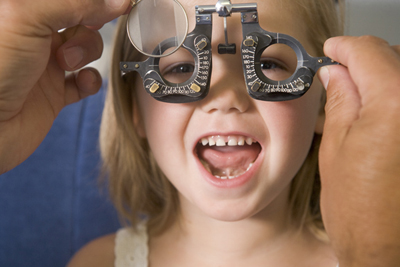 Many adults ask us, “how old does my child have to be before they can get an eye exam?” The correct answer – any age! The American Optometric Association recommends an eye exam on every child, once before age 1 year, at age 3, at age 5 and then every year while in school. While many doctors do not see children until they are around age 8, we have two doctors at Vision Palace Eye Care, Dr. Mattson and Dr. Cardiff, who will see infants, toddlers, and young children.
Many adults ask us, “how old does my child have to be before they can get an eye exam?” The correct answer – any age! The American Optometric Association recommends an eye exam on every child, once before age 1 year, at age 3, at age 5 and then every year while in school. While many doctors do not see children until they are around age 8, we have two doctors at Vision Palace Eye Care, Dr. Mattson and Dr. Cardiff, who will see infants, toddlers, and young children.
Why is important to have your child’s vision checked? For many reasons, first and foremost is that kids don’t understand what “clear” vision is. Children assume that their parents and other adults see the same way they do, so will not report things like double or blurry vision, headaches, or eyestrain. Also, a child’s visual system is still developing from birth to age 3 – a time called the “critical period”. It is during this time that conditions like an eye turn or “strabismus”, high farsightedness or nearsightedness, or uneven farsightedness or nearsightedness (anisometropia), can cause lazy eye or “amblyopia.”
Amblyopia
Amblyopia is the leading cause of vision loss in the United States in people under the age of 45 and it is completely treatable if caught early! This is the most important reason to have your child’s eyes examined. Amblyopia is frequently missed on school screenings or pediatrician screenings because the most common form of amblyopia, due to a difference in the farsightedness in each eye (refractive amblyopia), is not tested or the child “cheats” on their vision screening because they do not want to get the answers incorrect on the eye chart.
Amblyopia cannot be corrected with glasses alone, in many cases, patching is needed and should be done under the supervision of an optometrist or ophthalmologist. Children with amblyopia need frequent follow up (every 4-6 weeks) to test their vision and ensure that patching therapy is working as the best treatment is attained before age 8 or 9. However, some recent studies have shown that even teens and adults with amblyopia can improve some vision with treatment – so it is never too late. With that said – the BEST time to treat amblyopia is while the child is young and our doctors will help your child attain their best possible vision.
Vision related learning problems
Did you know that 80% of the information that your child is presented in school, is presented visually? When we think about this, it makes sense that children with uncorrected vision problems may have problems learning in school. These can sometimes manifest as “behavioral” or “inattention” problems, as children who can’t see clearly or comfortably may act out in a classroom setting.
Problems with uncorrected farsightedness, eye teaming, eye focusing, and eye tracking can all cause problems with reading. If the eyes do not work efficiently together, this creates an obstacle to efficient reading and therefore, reading comprehension. Sadly, many of these skills are not tested at vision screenings provided by schools, and sometimes, not by some eye doctors. A study released in the journal Optometry in 2007 showed that 80% of children classified as “poor readers” in high school, were deficient in 1 or more areas of eye focusing, eye teaming, or uncorrected farsightedness. Only 17% of these children would have failed a vision screening for distance acuity, which is the standard for school screenings in the U.S. (Optometry (2007) 78, 542-549).
The American Optometric Association estimates that 1/3 of children with vision problems are missed on school screenings, and most parents think that a school screening is the same as an eye exam by a doctor of optometry.
The State of New York requires that any child being evaluated for or placed on an Individualized Education Program (IEP) receive an eye exam by a doctor of optometry or ophthalmology. The eye exam needs to be scheduled within 90 days of the child being identified as needing services and there is a form that your child’s school should give you to have the doctor complete at the end of the examination.